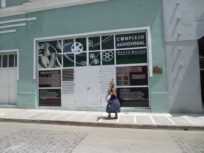What other city in Cuba -or elsewhere- can boast of having a “cinema street,” la calle de los cines? Camagüey’s calle de los cines is not new. Since the 1930s and 40s, this was the popular name for a stretch of Ignacio Agramonte Street in the heart of the city, flanked by two large, historic movie theaters: the Cine Encanto and the Cine Casablanca. It once also housed others, like the Salón Palatino that hosted the first film screening in Camaguey in 1908 and the Teatro Avellaneda that since 1913 regularly featured films from around the world. Since 2014 though, the calle de los cines has acquired a different valence. An urban renewal and cultural restoration project begun in the mid 2000’s, in preparation for the city’s 500th anniversary in 2014, has reimagined la calle de los cines as a space that celebrates cinema as a universal cultural phenomenon. The historic theaters have been restored (albeit multiplexed), new cultural centers have been established, and even the (state) businesses on the block have been renamed and re-themed on cinematic terms, like the Cafeteria “Coffea Arábiga” (in homage to filmmaker Nicolás Guillén Landrián) or the Peluquería (Hair Salon) “La ciudad de las mujeres,” after Fellini’s paradigmatic movie.
This may sound like a certain Disney-fication of cinematic culture, but beyond the paseo temático (theme park) aspect, there is serious work going on, especially within the Nuevo Mundo cultural complex, which is the hub of the street. Nuevo Mundo began in 1986 as a humble sala-video screening films in Betamax and, later, VHS. It was the first sala-video in Cuba (the screening room at L y 23 in Havana was only inaugurated months later) and was immensely popular. Today, in addition to screening spaces, the Complejo Cultural is the home of the Cátedra de Pensamiento Audiovisual Tomás Gutiérrez Alea, a documentation and information center, internet access point, and exhibition spaces. It has also been the home of the Film Criticism Workshop (Taller de la Crítica), the only event in Cuba focused on film criticism (and historiography), which is now on its 21st edition. Juan Antonio García Borrero, among Cuba’s most astute film critics and theorists and a native camagüeyano, has been central to many of these initiatives. His blog, Cine Cubano: La pupila Insomne, remains after more than a decade, an invaluable resource for anyone interested in the Cuban audiovisual universe.
Beyond the 2014 official unveiling of the restored Cine Casablanca, as the highlight of a reimagined calle de los cines, however, the recent announcement that Camagüey will host the first festival of Cuban cinema for television (in October in 2015) is very welcome news. The film criticism establishment, both in Cuba and abroad, has rarely acknowledged the existence of a significant number of audiovisual producers outside the official Cuban Film Institute or ICAIC. Only those who have crossed over from other institutions, like Ernesto Daranas and Tomás Piard, from the ICRT (Instituto Cubano de Radio y Televisión) are well known, but they are not the only ones. There is still much critical work to be done to fully understand the complexity of Cuba’s contemporary (and historical) audiovisual universe.
Thinking about “Greater Cuba” entails not only thinking about cinemas beyond the insula, but also about audiovisual productions marginalized by the singular focus on the mainstream (ICAIC). This festival will once again highlight Camagüey as the site for some of the edgier and most innovative thinking about the contemporary Cuban audiovisual scene.
-Ana M. López
Photo courtesy of Carolina Caballero
Ana M. López is the director of the Cuban and Caribbean Studies Institute, at Tulane University in New Orleans. She is also Associate Provost for Faculty Affairs, Professor of Communication, and a prolific author in the areas of Latino and Latin American cinema and media.


